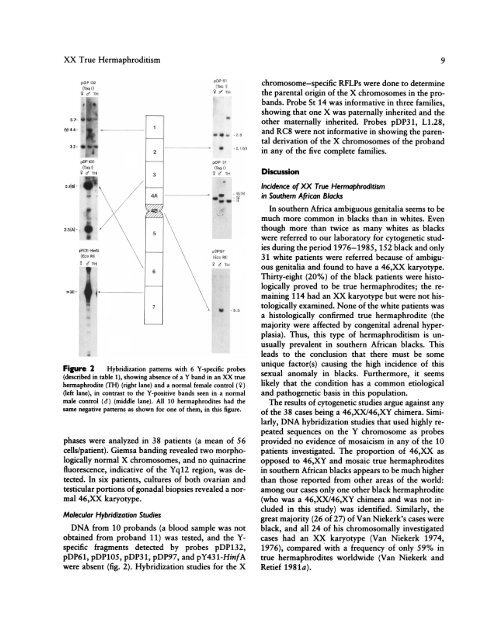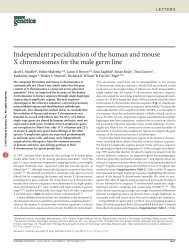XX True Hermaphroditism in Southern African Blacks - david page ...
XX True Hermaphroditism in Southern African Blacks - david page ...
XX True Hermaphroditism in Southern African Blacks - david page ...
- No tags were found...
You also want an ePaper? Increase the reach of your titles
YUMPU automatically turns print PDFs into web optimized ePapers that Google loves.
<strong>XX</strong> <strong>True</strong> <strong>Hermaphroditism</strong>chromosome-specific RFLPs were done to determ<strong>in</strong>ethe parental orig<strong>in</strong> of the X chromosomes <strong>in</strong> the probands.Probe St 14 was <strong>in</strong>formative <strong>in</strong> three families,show<strong>in</strong>g that one X was paternally <strong>in</strong>herited and theother maternally <strong>in</strong>herited. Probes pDP3 1, L1.28,and RC8 were not <strong>in</strong>formative <strong>in</strong> show<strong>in</strong>g the parentalderivation of the X chromosomes of the proband<strong>in</strong> any of the five complete families.9pDP12spPK"2a,0T 9 T674-M44-32-.IN-3130- _ \ il_1E1111_ t-~~~~~~~~~~~~5.5Figure 2 Hybridization patterns with 6 Y-specific probes(described <strong>in</strong> table 1), show<strong>in</strong>g absence of a Y band <strong>in</strong> an <strong>XX</strong> truehermaphrodite (TH) (right lane) and a normal female control (Y)(left lane), <strong>in</strong> contrast to the Y-positive bands seen <strong>in</strong> a normalmale control (ci) (middle lane). All 10 hermaphrodites had thesame negative patterns as shown for one of them, <strong>in</strong> this figure.phases were analyzed <strong>in</strong> 38 patients (a mean of 56cells/patient). Giemsa band<strong>in</strong>g revealed two morphologicallynormal X chromosomes, and no qu<strong>in</strong>acr<strong>in</strong>efluorescence, <strong>in</strong>dicative of the Yql2 region, was detected.In six patients, cultures of both ovarian andtesticular portions of gonadal biopsies revealed a normal46,<strong>XX</strong> karyotype.Molecular Hybridization StudiesDNA from 10 probands (a blood samplewas notobta<strong>in</strong>ed from proband 11) was tested, and the Y-specific fragments detected by probes pDP132,pDP61, pDP1OS, pDP31, pDP97, and pY431-H<strong>in</strong>fAwere absent (fig. 2). Hybridization studies for the XDiscussionIncidence of<strong>XX</strong> <strong>True</strong> <strong>Hermaphroditism</strong><strong>in</strong> <strong>Southern</strong> <strong>African</strong> <strong>Blacks</strong>In southern Africa ambiguous genitalia seems to bemuch more common <strong>in</strong> blacks than <strong>in</strong> whites. Eventhough more than twice as many whites as blackswere referred to our laboratory for cytogenetic studiesdur<strong>in</strong>g the period 1976-1985, 152 black and only31 white patients were referred because of ambiguousgenitalia and found to have a 46,<strong>XX</strong> karyotype.Thirty-eight (20%) of the black patients were histologicallyproved to be true hermaphrodites; the rema<strong>in</strong><strong>in</strong>g114 had an <strong>XX</strong> karyotype but were not histologicallyexam<strong>in</strong>ed. None of the white patients wasa histologically confirmed true hermaphrodite (themajority were affected by congenital adrenal hyperplasia).Thus, this type of hermaphroditism is unusuallyprevalent <strong>in</strong> southern <strong>African</strong> blacks. Thisleads to the conclusion that there must be someunique factor(s) caus<strong>in</strong>g the high <strong>in</strong>cidence of thissexual anomaly <strong>in</strong> blacks. Furthermore, it seemslikely that the condition has a common etiologicaland pathogenetic basis <strong>in</strong> this population.The results of cytogenetic studies argue aga<strong>in</strong>st anyof the 38 cases be<strong>in</strong>g a 46,<strong>XX</strong>/46,XY chimera. Similarly,DNA hybridization studies that used highly repeatedsequences on the Y chromosome as probesprovided no evidence of mosaicism <strong>in</strong> any of the 10patients <strong>in</strong>vestigated. The proportion of 46,<strong>XX</strong> asopposed to 46,XY and mosaic true hermaphrodites<strong>in</strong> southern <strong>African</strong> blacks appears to be much higherthan those reported from other areas of the world:among our cases only one other black hermaphrodite(who was a 46,<strong>XX</strong>/46,XY chimera and was not <strong>in</strong>cluded<strong>in</strong> this study) was identified. Similarly, thegreat majority (26 of 27) of Van Niekerk's cases wereblack, and all 24 of his chromosomally <strong>in</strong>vestigatedcases had an <strong>XX</strong> karyotype (Van Niekerk 1974,1976), compared with a frequency of only 59% <strong>in</strong>true hermaphrodites worldwide (Van Niekerk andRetief 1981 a).



